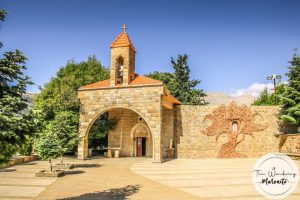Overview
Map
Other Details
كنيسة سيّدة الحقلة
Bane
Bcharre
North
كنيسة سيّدة الحقلة - بانبنيت سنة ١٨٨٣ كما تشير البلاطة التذكاريّة. هي كابيلا صغيرة تابعة للرعيّة بجانب المدافن تتألف من سوق واحد ينتهي بالمذبح. زيد عليها قنطرة المدخل والقرميد أواخر القرن العشرين. لوحتها من صنع أوروبي تعود لسنة ١٩٢٣.The church of Our Lady of the fields - BanThe church was built in 1883 as it is shown by the epitaph. The church is a small chapel near the cemetery. It consists of one nave ending with the altar. A gateway and a tiled roof were added at the end of the XXth century. The painting is imported from Europe and dates back to 1923.
Visited 2129 times, 1 Visit today















Reviews are disabled, but trackbacks and pingbacks are open.